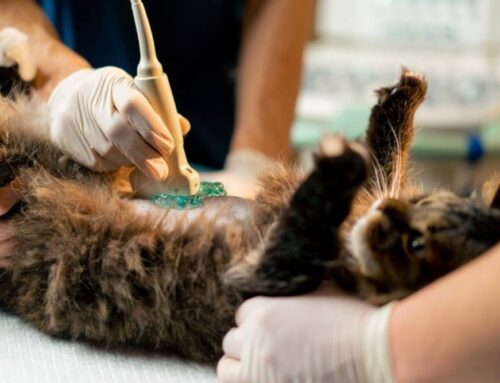Does your cat gaze wistfully out the window?
Does your cat attempt a “jail-break” every time you open the door, and then claw madly at the window, as if rattling their cell bars?
Don’t they know how good they’ve got it living an indoor-only life? You’re providing the safest, healthiest care, and meeting their every physical need, and yet they stare at you with big pleading eyes—an expression they surely learned from those heart-wrenching animal charity commercials.
They’re not entirely wrong—indoor cats frequently suffer from a lack of environmental satisfaction, because our homes aren’t designed to meet their instinctive needs. Help your cat act out their natural instincts—without turning your home into a jungle—with this guide to feline environmental enrichment from Village Animal Hospital.
What is feline environmental enrichment?
The enrichment concept originates from captive animal care (e.g., sanctuaries and zoos) where formerly wild animals experienced stress-related illness and disease when kept in an inappropriate environment. Considering the cat’s carnivorous nature and strong hunting instincts, domesticated life provides few thrills. But, your cat’s emotional state is more than a mood—without an appropriate indoor environment, cats are at a higher risk for stress-related health conditions and illnesses, including:
- Obesity
- Feline lower urinary tract disease (FLUTD)
- Aggression
- Compulsive disorders (e.g., over grooming)
- Upper respiratory infections
Helping cats feel safe and secure in their home is as essential for their health and wellbeing as routine veterinary care. Plus, the process is fun and rewarding for all.
Behavior problems? Start with a veterinary visit
If your cat is currently demonstrating behavior problems (e.g., house soiling, spraying, aggression), schedule an appointment at Village Animal Hospital. Environmental enrichment will improve your cat’s quality of life, but does not replace veterinary care. And, since many behavior problems have a medical cause, having your cat examined before altering their environment is essential.
Your cat’s environmental “needs” list
Your cat’s dream home begins with understanding their behavior and instinctive needs, including:
- Safety — Cats hunt alone and need to protect themselves from perceived threats, especially while resting. They also prefer to travel without being noticed—ideally behind a visual barrier.
- Resources — Cats are territorial and can become stressed by environmental changes (e.g., the ability to access food, water, hiding places, and the litter box).
- Socialization — Cats appreciate social interaction, but each cat has their own preferences on how much they need and what kind (e.g., human or feline).
- Communication — In addition to vocalizing, cats send messages through scent deposits (e.g., urine, pheromones) and body language. Their acute smell and hearing senses are easily overwhelmed by strong odors and unfamiliar noises.
Your feline environmental enrichment blueprint
Now that you know your goal, lay out your plan. Here are five essential ways to ensure your indoor cat’s lifelong happiness and comfort.
#1: Provide your cat with places to hide and stalk
Look at your home through your cat’s eyes. Can they slip behind the couch? Can they travel along a room’s perimeter without feeling exposed? If not, try rearranging your furniture to create feline-friendly hiding places and narrow passageways.
#2: Give your cat a good resting place
Although some cats seem to relish being in the center of things, most prefer a quiet retreat at nap time. Place cozy cat beds in warm, secluded locations—your cat will appreciate the privacy. If you have more than one cat, ensure they have plenty of options throughout your home.
#3: Satisfy your cat’s inner hunter with food games
How you feed your cat matters. Say goodbye to the boring bowl and twice-daily meals. Instead, replace mealtime with food toys and puzzles that engage your cat’s desire to hunt and forage. These slow feeding techniques also increase your cat’s activity and manage their weight.
Ensure all cats in the home are separated for these games, to prevent competition-induced stress. Ensure you provide the toys in a quiet, safe area where no loud noises or unpredictable activity may frighten your cat. Favorite feline feeders include:
- Treat-filled balls
- Reach boxes
- Snuffle mats
- Hiding food throughout a room
Introduce puzzle toys gradually, and don’t make your cat work for their entire portion during the learning process, which could frustrate your cat, and teach them to avoid new things.
#4: Elevate your cat’s happiness with vertical spaces

Does your cat have an appropriate climbing place? Cats crave the safety and efficiency of tall perches where they can observe household activity, while remaining secure from potential threats.
Cat trees and cat furniture can form your cat’s multi-purpose paradise. Many models include scratching posts, hiding boxes, and cozy perches. But, if feline furniture doesn’t fit your aesthetic, you can modify human furniture using non-slip mats.
#5: Treat your cat to regular social interaction
If your cat was human, would they be the hugging or wave-from-a-distance type? Both types deserve intentional social time with their owner. No matter what your cat considers “attention,” ensure they have regular opportunities to engage and interact as they want. And, who knows—that shy wallflower may become a cuddlebug!
Satisfying your cat’s needs goes far beyond food and water in bowls and a litter box. Allowing your cat to express natural behaviors on a daily basis improves their emotional and physical health, avoids undesirable behavior, and deepens the cat-owner bond. For focused feline behavioral counseling, schedule an appointment at Village Animal Hospital.








Leave A Comment